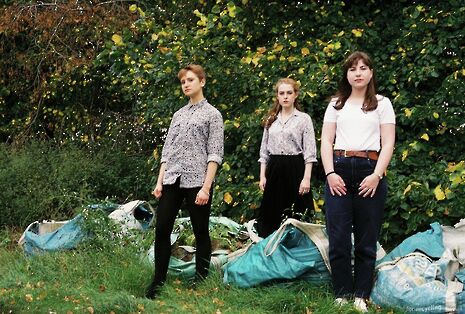Review: Can’t Stand Up For Falling Down
“A captivating polyphonic tale” writes Anna Shmatenko on Imogen Osborne’s Michaelmas directorial debut

The shop. The river banks. The quarries. As Lynette (Grace England), Ruby (Ashleigh Weir) and Jodie (Sarah Taylor) slowly open up to us in the course of the play’s just-over-an-hour run, letting us take a peek into the sacred chamber of their deeply personal life stories, we cannot help but notice that their distinct voices mysteriously sketch the outlines of the same locations.
The moment we begin to trace the similarities between the places they describe, we quickly realise that it’s not just a shared geography that their words repeatedly flesh out – it is also the same people, or rather the same person at the centre and behind it all. That is to say, at the centre of their realities, and behind all their sorrows.
Can’t Stand Up For Falling Down is a captivating polyphonic tale about a man, whose threatening presence looms over and permeates every aspect of the three women’s wounded lives. Impressively, this effect of absolute domination is achieved without the man himself ever actually stepping out into the glow of the theatre lights, and it is this invisibility that supplies the story with more than its fair share of menace and trauma.
“For once, as an audience member, it is great to feel trusted with responsibility to weave the threads of seemingly unconnected tales into a unified narrative pattern”
The script treats us with a solemn respect – it beckons us without being too pushy and provides us with just enough narrative material, so that we can mentally supply the missing links and small narrative fragments to connect the three stories together without ever actually doing it in an overly explicit fashion.
For once, as an audience member, it is great to feel trusted with responsibility to weave the threads of seemingly unconnected tales into a unified narrative pattern instead of having to sit through superfluous scenes, in which everything that requires just a little thought gets explained to the non-existent group of those theatre-goers who simply ‘didn’t get it’.
The execution, however, isn’t without its flaws, but this is definitely not what the play should be remembered by. The piece gains momentum and is increasingly gripping as it heads towards its end. The first half of the show mostly consists of a block of monotonous prose, which feels like it’s being read to us rather than performed, as it is only occasionally sprinkled with engaging impersonations. Even the actors seem to have a hard time ploughing through the enormous body of unbroken text without leaving some parts uncoloured by emotional hues.

However, once the lights go out, roughly by the middle of the play’s run, announcing the beginning of the second part of the show, it’s as though the dull seed that took so much of everyone’s patience to plant finally blooms in its full splendour. The low energy of the first half, which feels more like a warm-up than a part of the actual show, is substituted with boisterousness and activity.
As the narrative shifts from the memories of their childhoods to their immediate present, the tales pick up the pace. The voices of the three women switch between one another more rapidly, keeping us alert at all times, and regardless of the direction the stories take, we always find ourselves caught in dramatic twists and turns alongside the three heroines. The world, the bustle of which we only disinterestedly overheard in the first half of the show, suddenly floods us with its pleasantly overwhelming realities.
The most notable and praiseworthy element of the show is the inexhaustible number of ways the director (Imogen Osborne) finds to animate dialogue and interaction between two people, one of whom is an actor on stage and the other an empty space, ready to be filled by our excited imaginations.
“The script treats us with a solemn respect – it beckons us without being too pushy”
There are eerily transformative impersonations, pre-recordings of different voices, multi-roling, and even one-sided dialogue, which create such an accurate illusion of completeness that there can be no doubt about what the invisible person is saying.
The most brilliant, most memorable instance of all is the physical struggle between Lynette and her husband. Grace England acts out the infliction of violence on her person so flawlessly, that it is too easy to forget that she is the only person on stage. These different modes of single-handedly conveying a reality shared by two people allow the actors to explore the multifarious facets of experience in a challenging, yet rewarding manner.
The subtleties and fluidity of the lighting are deserving of an honourable mention for such seamless transition, which completes the illusion of an invisible crowd inhabiting the stage.
Should you decide to watch the show, I recommend you watch your step in the theatre – you can never be sure that an invisible person won’t trip you up when you least expect it
 Features / Cold-water cult: the year-round swimmers of Cambridge21 June 2025
Features / Cold-water cult: the year-round swimmers of Cambridge21 June 2025 Comment / Good riddance to exam rankings20 June 2025
Comment / Good riddance to exam rankings20 June 2025 Theatre / Do Cambridge audiences actually get theatre? 22 June 2025
Theatre / Do Cambridge audiences actually get theatre? 22 June 2025 News / Magdalene evicts pro-Palestine encampment24 June 2025
News / Magdalene evicts pro-Palestine encampment24 June 2025 Lifestyle / What’s worth doing in Cambridge? 19 June 2025
Lifestyle / What’s worth doing in Cambridge? 19 June 2025




